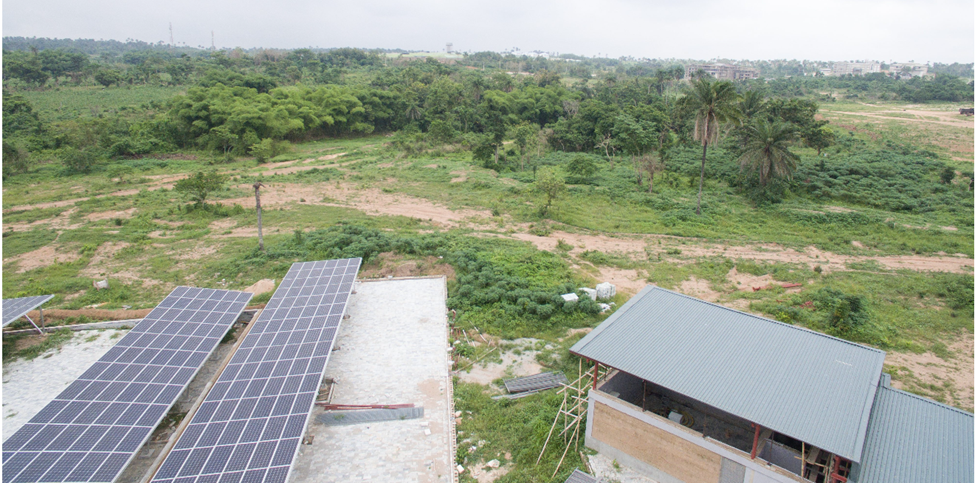Low Carbon Energy Measurement Across the University

Measuring Low Carbon Energy Generation at Redeemer’s University: A Step Towards Sustainability
As part of Redeemer’s University’s ongoing commitment to sustainability and reducing its carbon footprint, several measures have been put in place to harness renewable energy sources and improve energy efficiency on campus. The university is taking significant strides to transition towards low-carbon energy solutions, with solar power playing a pivotal role in powering its administrative buildings and new research facilities. In addition to using solar energy, innovative design and construction techniques are being employed to create environmentally friendly buildings that contribute to the university’s sustainability goals.
Solar Power for Administrative Buildings
The administrative buildings at Redeemer’s University are now powered entirely by solar energy, marking a major milestone in the university's sustainability journey. By harnessing the abundant solar energy available in the region, Redeemer’s University is significantly reducing its reliance on conventional fossil fuels and lowering its overall carbon emissions.
Measurement of Solar Energy Usage:
To ensure the effectiveness of this transition to solar power, the university has implemented a systematic process to measure the amount of solar energy generated and consumed by its administrative buildings:
- Installation of Solar Panels: High-efficiency solar panels have been installed across all administrative buildings. These panels are equipped with energy monitoring systems that track the total amount of energy generated on a daily, monthly, and annual basis.
- Comparison of Roles: The audit compares salaries of male and female employees in similar roles, with a focus on equal pay for equal work. Factors such as experience, qualifications, and job responsibilities are considered to ensure fair comparisons.
- Real-Time Energy Monitoring: The university uses real-time energy monitoring systems to measure the output of the solar panels, which provides valuable data on the energy generated versus the energy consumed by the buildings. This data helps in understanding peak generation times and allows the university to optimize energy usage patterns.
- Carbon Emission Reductions: The energy monitoring systems also calculate the corresponding reduction in carbon emissions. By comparing the energy generated from solar power to the equivalent energy that would have been generated from fossil fuels, the university is able to quantify its reduction in greenhouse gas emissions and contribute to its low-carbon energy goals.
Solar Power and Eco-Friendly Design of the African Center for the Genomics of Infectious Diseases (ACEGID)
The newly constructed African Center for the Genomics of Infectious Diseases (ACEGID) edifice at Redeemer’s University is another excellent example of how the university is integrating sustainable practices into its energy usage. The building is powered in part by solar panels, providing clean and renewable energy to support its daily operations.
However, the building’s sustainability efforts go beyond the use of solar power. The conception, design, and construction of ACEGID have been focused on creating an environmentally friendly edifice that minimizes energy requirements and enhances natural energy efficiency.
Environmentally Friendly Design Features
- Orientation for Natural Cooling: The ACEGID building has been designed with its orientation towards the wind direction, allowing for natural ventilation and cooling. By taking advantage of natural breezes, the need for artificial cooling systems such as air conditioners is greatly reduced, contributing to lower energy consumption.
- Rammed Earth Walls: The building’s walls are constructed from rammed earth, a sustainable building material made from local soil mixed with a waterproofing compound. Rammed earth has excellent thermal properties, as the walls absorb heat during the day and release it at night. This natural temperature regulation reduces the need for artificial heating and cooling, which further lowers the building’s energy consumption.
- Natural Vegetation for Climate Mitigation: Trees and shrubs native to the region have been strategically planted around the building to help mitigate the effects of hot and wet temperatures. This natural landscaping not only enhances the building’s environmental footprint but also provides shade and cooling, reducing the building’s energy requirements for temperature control.
Measuring Energy Efficiency and Environmental Impact
In addition to monitoring solar energy usage, Redeemer’s University is actively tracking the energy efficiency and environmental impact of the ACEGID building:
- Energy Consumption Monitoring: Advanced energy monitoring systems have been installed within the building to track energy consumption. By comparing energy usage with the amount of solar energy generated, the university can assess how well the building’s design features, such as natural cooling and rammed earth construction, contribute to overall energy savings.
- Thermal Performance Tracking: The thermal performance of the rammed earth walls is also being measured. Sensors track the temperature variations within the building, providing data on how effectively the walls are maintaining internal temperatures without the need for extensive artificial heating or cooling.
- Reduction in Energy Demand: Through this process, the university is able to calculate the reduction in energy demand attributed to the building’s environmentally friendly design. The lower energy needs directly translate to fewer carbon emissions, contributing to the university’s goal of becoming a low-carbon campus.
Conclusion: A Commitment to Sustainability and Low Carbon Energy
Redeemer’s University’s ongoing transition towards low carbon energy is a reflection of its commitment to sustainability, innovation, and responsible environmental stewardship. The integration of solar power in administrative buildings and the ACEGID facility, combined with the use of environmentally friendly building designs, demonstrates the university’s proactive approach to reducing energy consumption and carbon emissions.
The university’s process of measuring and tracking energy generation and efficiency ensures that these efforts are not only effective but also aligned with long-term sustainability goals. By continuously monitoring energy usage and exploring further opportunities for low-carbon solutions, Redeemer’s University is positioning itself as a leader in environmental sustainability in Nigeria and beyond.
Latest News
-
Redeemer's University Launches New Initiative for SDG 1
Published on: October 22, 2024
-
New Study Shows Effective Measures in Poverty Reduction
Published on: October 19, 2024
-
Global Summit Addresses the Future of Sustainable Development
Published on: October 15, 2024